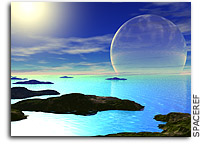Vegetation’s Red Edge: A Possible Spectroscopic Biosignature of Extraterrestrial Plants

http://images.spaceref.com/news/early.earth.jpg
Astrophysics, abstract
astro-ph/0503302
From: Eric B. Ford [view email]
Date: Mon, 14 Mar 2005 21:22:22 GMT (350kb)
Vegetation’s Red Edge: A Possible Spectroscopic Biosignature of
Extraterrestrial Plants
Authors:
Sara Seager (DTM),
Edwin L. Turner (Princeton),
Justin Schafer (Princeton),
Eric B. Ford (UCB)
Comments: 19 pages, 6 figures, to appear in Astrobiology
Earth’s deciduous plants have a sharp order-of-magnitude increase in leaf
reflectance between approximately 700 and 750 nm wavelength. This strong
reflectance of Earth’s vegetation suggests that surface biosignatures with
sharp spectral features might be detectable in the spectrum of scattered light
from a spatially unresolved extrasolar terrestrial planet. We assess the
potential of Earth’s step-function-like spectroscopic feature, referred to as
the "red edge", as a tool for astrobiology. We review the basic characteristics
and physical origin of the red edge and summarize its use in astronomy: early
spectroscopic efforts to search for vegetation on Mars and recent reports of
detection of the red edge in the spectrum of Earthshine (i.e., the spatially
integrated scattered light spectrum of Earth). We present Earthshine
observations from Apache Point Observatory to emphasize that time variability
is key to detecting weak surface biosignatures such as the vegetation red edge.
We briefly discuss the evolutionary advantages of vegetation’s red edge
reflectance, and speculate that while extraterrestrial "light harvesting
organisms" have no compelling reason to display the exact same red edge feature
as terrestrial vegetation, they might have similar spectroscopic features at
different wavelengths than terrestrial vegetation. This implies that future
terrestrial-planet-characterizing space missions should obtain data that allow
time-varying, sharp spectral features at unknown wavelengths to be identified.
We caution that some mineral reflectance edges are similar in slope and
strength to vegetation’s red edge (albeit at different wavelengths); if an
extrasolar planet reflectance edge is detected care must be taken with its
interpretation.
Full-text: PostScript, PDF, or Other formats
References and citations for this submission:
SLAC-SPIRES HEP (refers to ,
cited by, arXiv reformatted);
CiteBase (autonomous citation navigation and analysis)
Which authors of this paper are endorsers?








